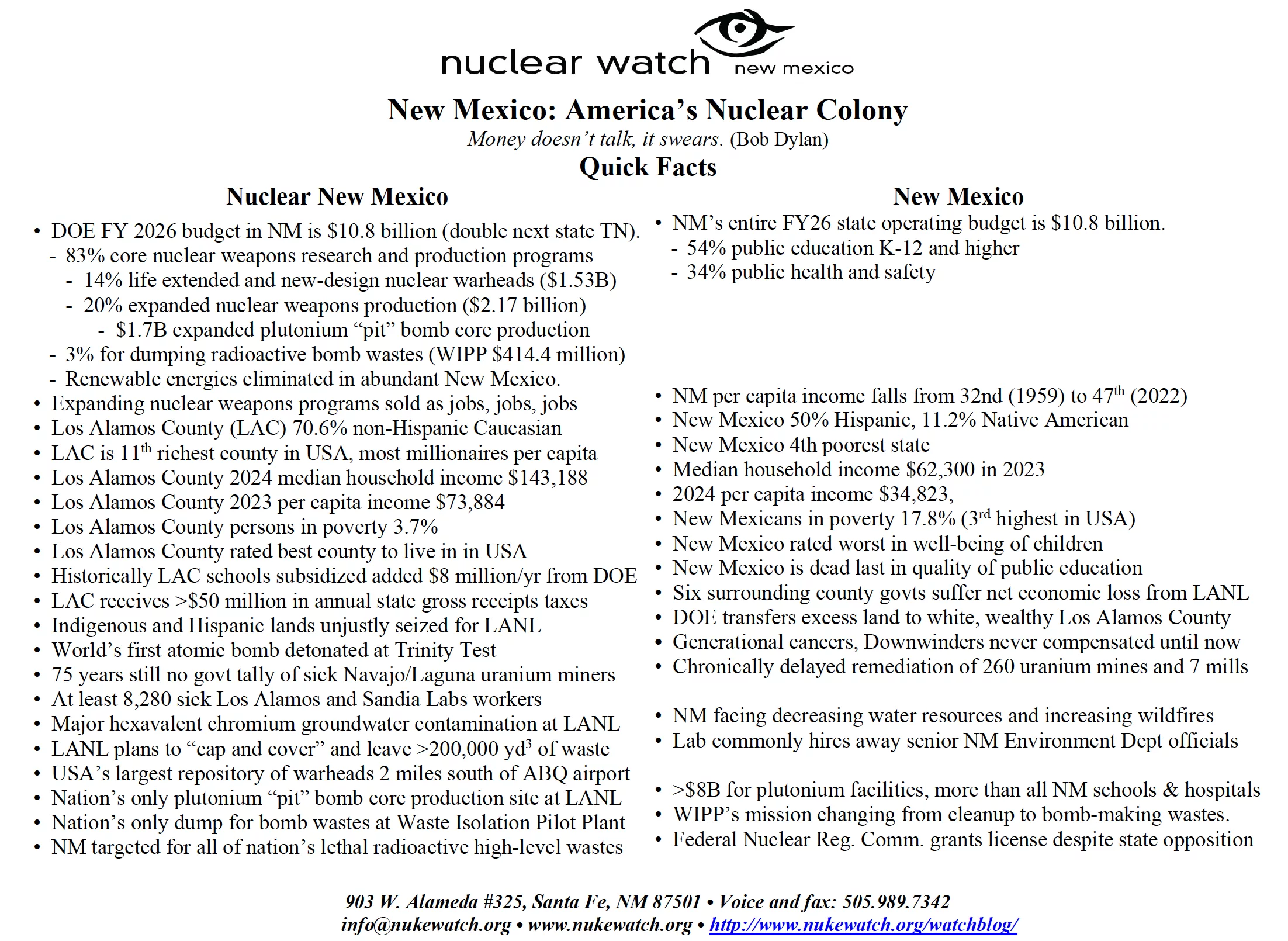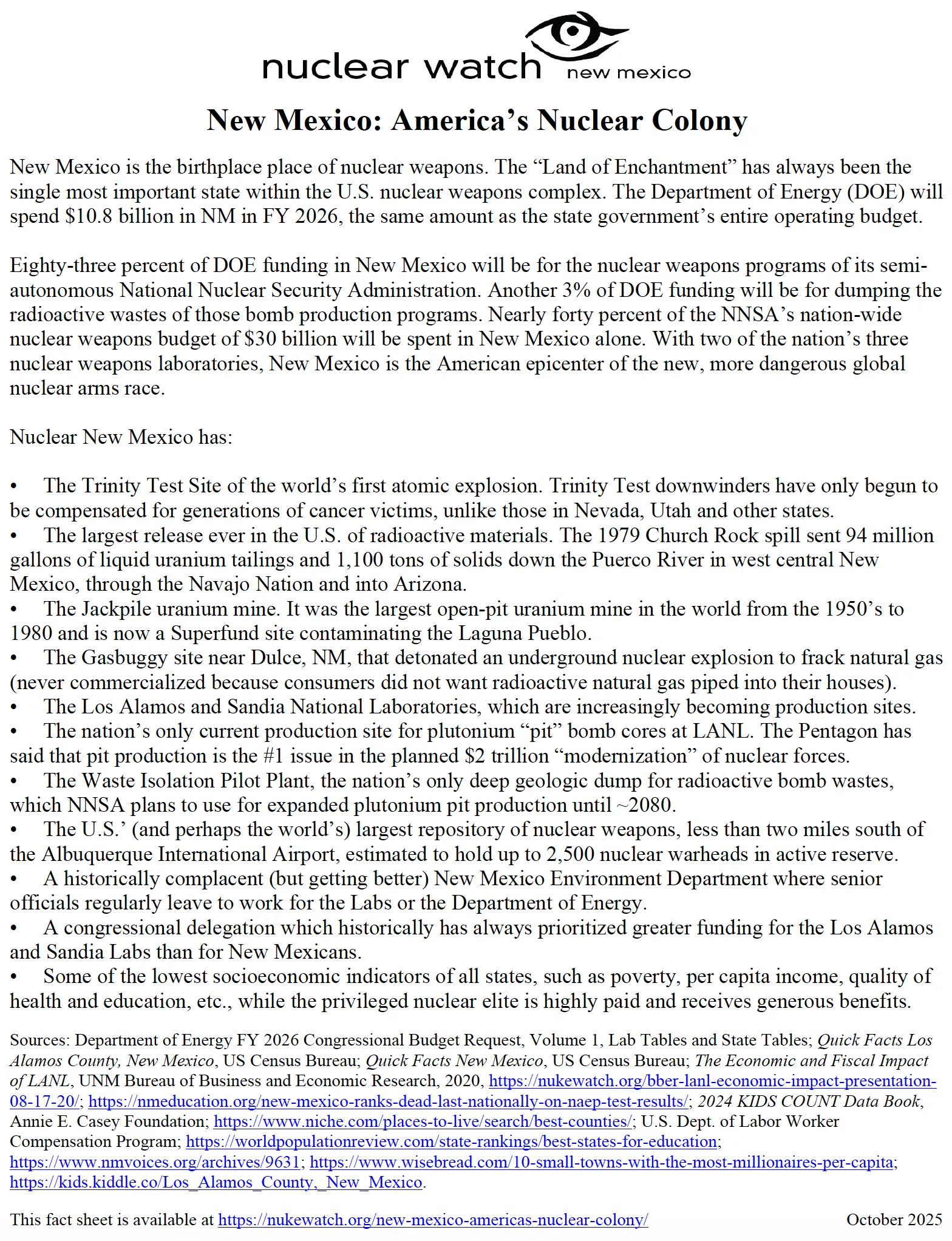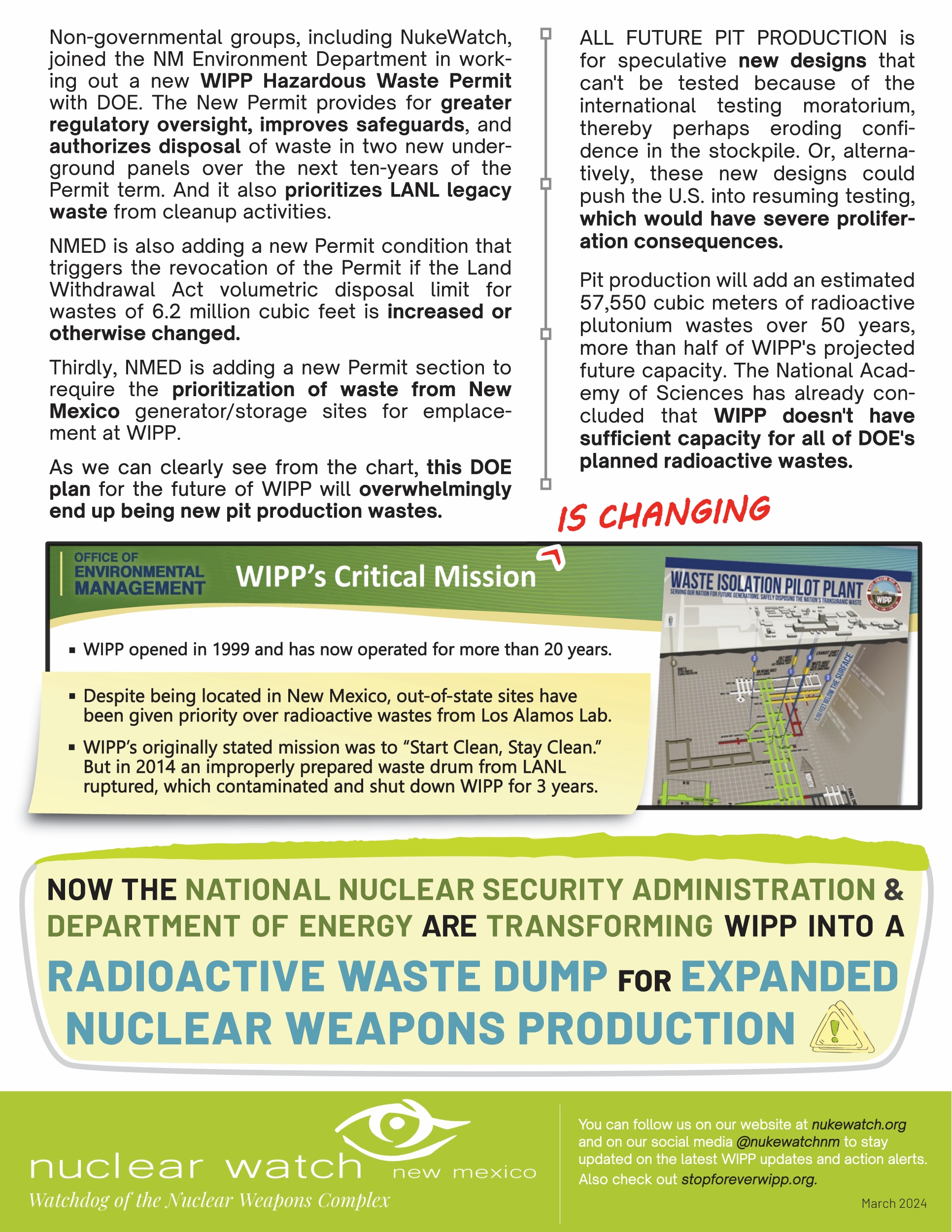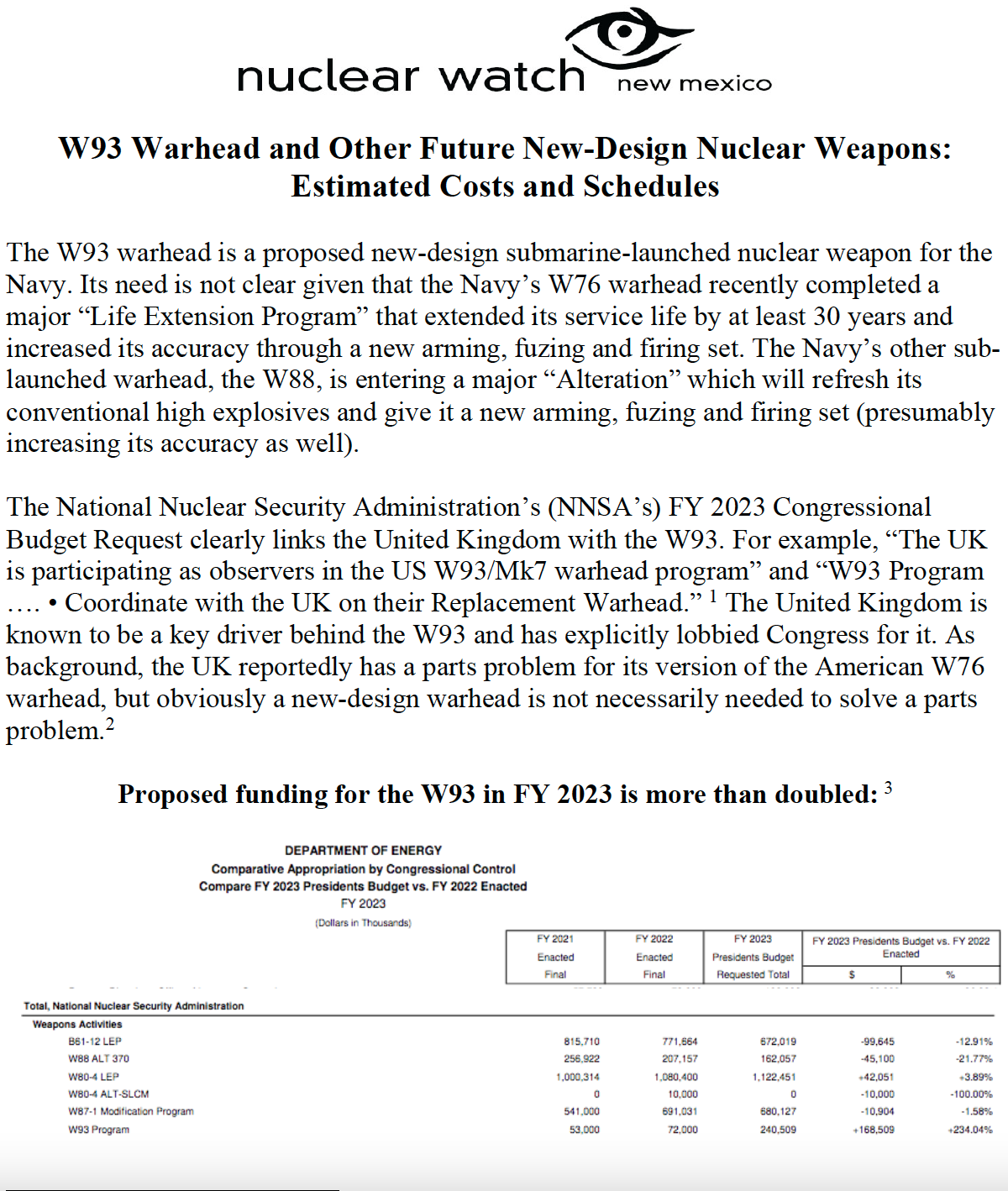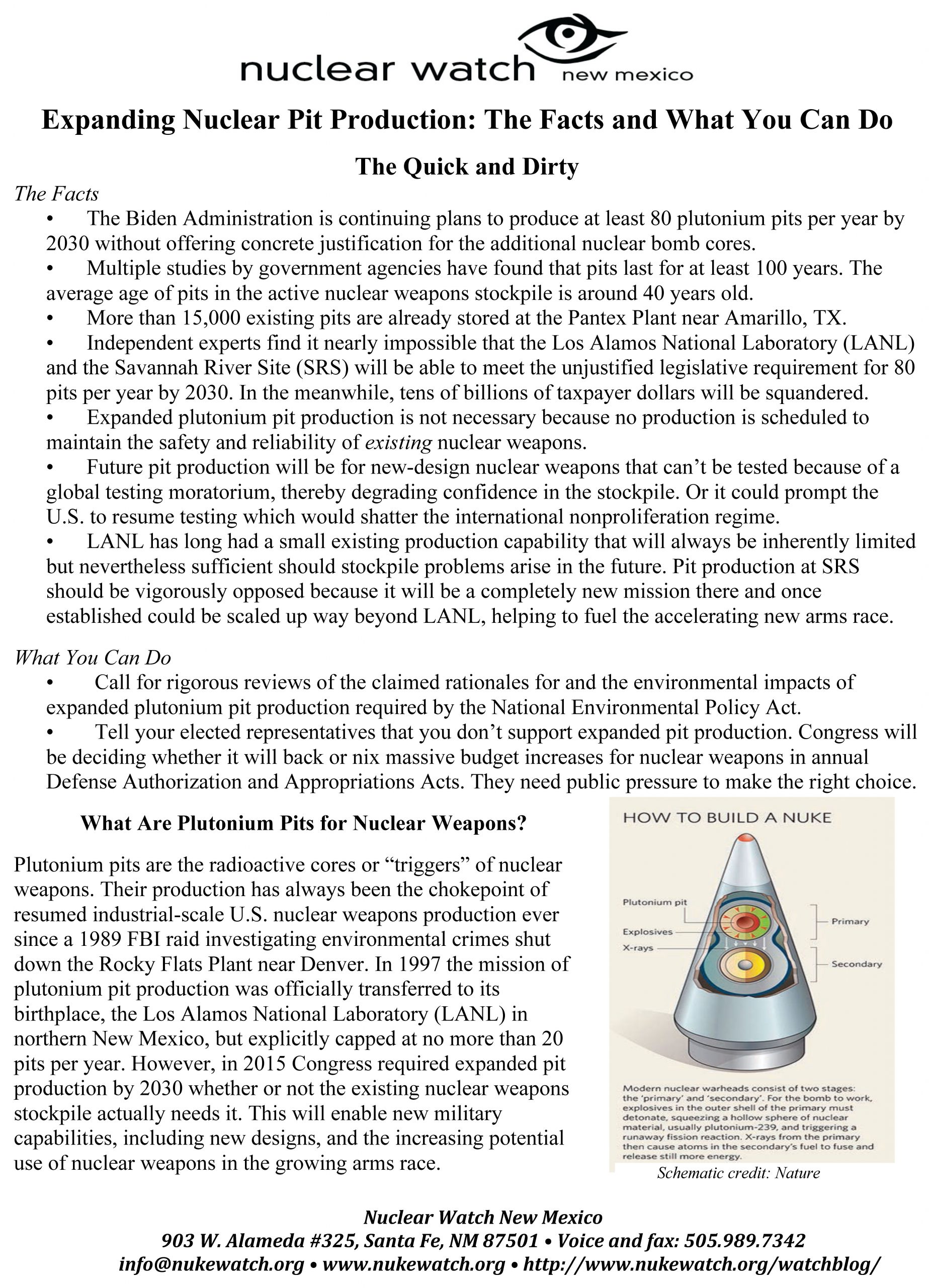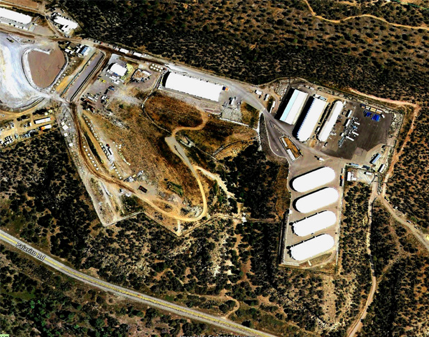QUICK SEARCH
| Title | Link |
|---|---|
| Plutonium Pit Production Fact Sheet – July 2024 | View/Download |
| WIPP March 2024 Fact Sheet/Infographic | View/Download |
| New Mexico – America’s Nuclear Colony 6-1-23 | |
| WIPP Infographic Updated 5-1-23 | View/Download |
| WIPP Infographic 2-1-23 | View/Download |
| PLUTONIUM PIT PRODUCTION BRIEFING 1-7-23 | View/Download |
| A Guide to “Scoping” the New LANL SWEIS 9-9-22 | View/Download |
| The Need for Independent Pit Aging Studies 6-16-22 | View/Download |
| Why Funding for the SLCM Nuclear Warhead Should Be Deleted 6-1-22 | View/Download |
| W93 Warhead and Other Future New-Design Nuclear Weapons: Estimated Costs and Schedules 4-4-2022 | View/Download |
| Plutonium Pit Production Fact Sheet 11-4-21 | View/Download |
| Critique of the RCLC Amended Joint Powers Agreement 3-27-21 | View/Download |
| Local Governments Should Leave the Regional Coalition of LANL Communities 3-13-21 | View/Download |
| Why the 2016 LANL Consent Order Should be Changed 1-10-21 | View/Download |
| A Critique of Some NNSA Answers to Questions on LANL’s Planned Tritium Releases 11-4-20 | View/Download |
| Potential Health Effects of Tritium 10-15-20 | View/Download |
| Why the 2016 LANL Cleanup Consent Order Should Be Changed 1-9-20 | View/Download |
| Plutonium Pit Production Fact Sheet 11-19-19 | View/Download |
| Is Los Alamos Lab Half Empty or Over Full of Radioactive Wastes? 8-22-19 | View/Download |
| Pit Production Fact Sheet 7-2-19 | View/Download |
| LANL Genuine Cleanup Background Summary 6-26-19 | View/Download |
| LANL Genuine Cleanup Backgrounder 6-26-19 | View/Download |
| Los Alamos Lab Consent Orders Comparison 4-26-19 | View/Download |
| DNFSB Talking Points 02-14-2019 | View/Download |
| Plutonium Pit Production NEPA Talking Points 01-01-2019 | View/Download |
| Pit Production History 12-20-18 | View/Download |
| ANA DNFSB Fact Sheet 11-28-18 | View/Download |
| Plutonium Pit Production Fact Sheet 11-16-18 | View/Download |
| ANA DNFSB Hearing Fact Sheet 8-24-18 | View/Download |
| Sandia National Laboratories Backgrounder 9-26-14 | View/Download |
| Los Alamos Lab Backgrounder 9-26-14 | View/Download |
| Area G Cleanup Jobs 12-11-13 | View/Download |
The Need for Independent Pit Aging Studies
June 16, 2022 | FACT SHEETS
Summary: The United States is aggressively expanding the production of plutonium “pit” bomb cores to at least 80 pits per year, which the Pentagon has called the number one issue in its $1.7 trillion plan to “modernize” nuclear forces. The average age of plutonium pits is around 40 years. Los Alamos Lab Director Thom Mason has said that “The best way to deal with this dilemma [of uncertainty about aging effects] is to take it off the table. We do that by making new pits, immediately.” Thus, he justifies spending tens of billions of dollars, creating additional occupational and public risks, generating more radioactive wastes with uncertain disposal pathways, fundamentally transforming the Lab into a nuclear weapons production site and fueling the increasingly dangerous new nuclear arms race.
But does independent review of pit aging data support this need to immediately produce new pits? The answer is no given that independent experts concluded in 2006 that pits last at least a century with no determined end date. Further, no future pit production is scheduled to maintain the safety and reliability of the existing nuclear weapons stockpile – it is all for speculative new designs which could raise reliability issues or even prompt the U.S. to resume testing.
Why Funding for the SLCM Nuclear Warhead Should Be Deleted
June 6, 2022 | FACT SHEETS
Introduction: In 1991, in response to the ongoing collapse of the Soviet Union, President George H. Bush ordered the withdrawal of all nuclear-armed sea-launched cruise missiles (SLCMs) from U.S. surface ships and submarines. In 2018 President Trump’s Nuclear Posture Review proposed to redeploy SLCMs on Virginia-class attack submarines, saying they would provide the United States with “a needed non-strategic regional presence” that would address “the increasing need for flexible and low-yield options.”1 Congress subsequently approved $15.2 million in FY 2022 funding for the Navy’s new cruise missile and nuclear warhead.
In March 2022 President Biden transmitted a new classified Nuclear Posture Review to Congress that reportedly canceled the Sea-Launched Cruise Missile. In parallel, his proposed FY 2023 budget for the National Nuclear Security Administration (NNSA) has no funding for the SLCM nuclear warhead. This has prompted some congressional pushback, with one suggested compromise being continuing modest research funding. But as a Congressional Research Service analysis put it: “The Navy indicated that the program was “cost prohibitive and the acquisition schedule would have delivered capability late to need.”
Is Los Alamos Lab Half Empty or Over Full of Radioactive Wastes?
August 22, 2019
The Department of Energy’s (DOE’s) Environmental Management Los Alamos (EMLA) field office has repeatedly claimed that “> [i.e., more than] ½ of legacy cleanup has been completed.”1 This claim doesn’t explain how this is measured. Does it mean ½ of the time, ½ of the cost, ½ of the sites, or ½ of the wastes? However it is measured, New Mexicans need to know that DOE and the Los Alamos National Laboratory (LANL) are NOT talking about real comprehensive cleanup.
When EMLA and its cleanup contractor (N3B) talk about cleanup, they mean specific narrow measures for specific sites, including much paperwork and studies instead of actual cleanup. Contrary to EMLA’s self-proclaimed openness and transparency, the claim of greater that half-completed cleanup is based on decisions made without public input to leave the vast majority of radioactive and toxic wastes permanently buried above our precious groundwater.
While some Lab cleanup started in the late 1980s, tracking of the cleanup budget didn’t start until 1997, which is the date used as the beginning of “prior costs” in recent DOE Congressional Budget Requests. 2 EMLA’s current estimated date for completion of planned cleanup is 2037. That would be 22 years down and 18 to go, if we look at 1997 to 2037, which would be ½ of the time if EMLA completes its planned cleanup by 2037. If decisions are made to remove more wastes, which would be the right thing to do, cleanup could last for decades more while generating 100’s of high-paying jobs. Real, comprehensive cleanup would be well worth the wait!
A Tale of Two Consent Orders and What Is Needed
On March 1, 2005, after arduous negotiations and threats of litigation, the New Mexico Environment Department (NMED), Department of Energy (DOE), and Los Alamos National Laboratory (LANL) entered into a Consent Order specifying the schedule for investigation and cleanup of the Lab’s hundreds of contaminated sites.
In June 2016, NMED and LANL signed a new Consent Order that solved many of LANL’s problems by removing fines and enforceable schedules.
Read/Download the full fact sheet pdf HERE
Expanded Plutonium Pit Production for U.S. Nuclear Weapons
Plutonium pits are the radioactive cores or “triggers” of nuclear weapons. Their production has always been a chokepoint of resumed industrial-scale U.S. nuclear weapons production ever since a 1989 FBI raid investigating environmental crimes shut down the Rocky Flats Plant near Denver.Continue reading
Clean Up Area G: Hundreds of Jobs Could Be Created that Protect the Environment
Summary
New Mexicans should push their politicians to vigorously lobby for comprehensive cleanup at the Los Alamos National Laboratory (LANL). Unlike nuclear weapons programs, cleanup would be a win-win that permanently protects the environment while creating hundreds of high paying jobs. Continue reading
Expanded Plutonium Pit Production at LANL Will Not Result in Significant Positive Effect On Job Creation and the Regional Economy
The National Nuclear Security Administration’s own documents have explicitly stated that expanded pit production would have no significant positive effect on job creation and the regional economy of northern New Mexico. Nuclear Watch argues that expanded plutonium pit production could actually have negative effect if it blocks other economic alternatives such as comprehensive cleanup, which could be the real job producer.Continue reading


